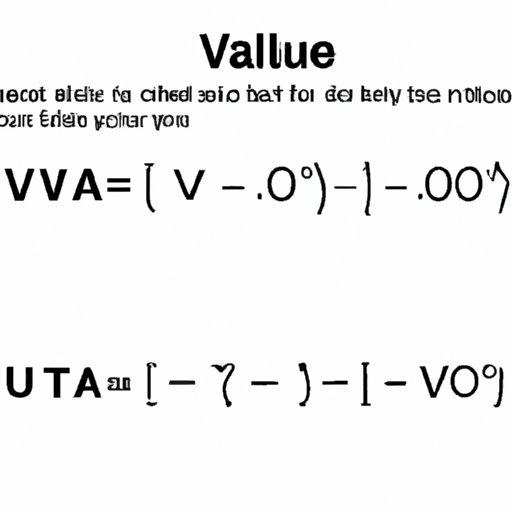
I. Introduction
Have you ever encountered an equation that required you to find the distance between two points, but both points were represented by negative numbers? You may have found yourself confused about what the answer could possibly be – after all, how can you have negative distance?
This is where the concept of absolute value comes in. Absolute value is an essential mathematical concept that allows us to determine the distance between numbers, regardless of whether they are positive or negative. Whether you’re a student encountering absolute value for the first time or an adult needing a refresher, understanding how to find absolute value is crucial to succeeding in math and science.
II. Basic Concept of Absolute Value
Before diving into how to find absolute value, let’s first investigate what exactly absolute value is. The absolute value of a number, represented by vertical bars or pipes surrounding the number, simply refers to how far away the number is from zero on a number line. In other words, the absolute value of a number is always positive and represents the distance between that number and zero.
A few important properties of absolute value are:
- Absolute value is always non-negative (or, positive or zero), regardless of whether the original number was positive or negative
- Absolute value is symmetric – meaning, the distance between a number and zero is the same as the distance between the opposite of that number and zero
- Absolute value cannot be used to discover the original sign of a number
Examples of where absolute value might come up include determining the magnitude of a vector in physics, calculating ranges in statistics, and finding distance between two points in algebra.
III. Step-by-Step Guide to Finding Absolute Value
To find the absolute value of a number:
- If the number is positive, simply write the number without any additional symbols or changes
- If the number is negative, remove the negative sign and replace it with a positive sign
- The result is the absolute value of the original number, always expressed as a positive value
Consider the following examples:
- The absolute value of 5 is 5, since 5 is already a positive number
- The absolute value of -7 is 7, since we remove the negative sign and replace it with a positive sign
- The absolute value of 0 is 0, since 0 is already a non-negative number
You can practice finding absolute value with the following problems:
- Find the absolute value of 12
- Find the absolute value of -23
- Find the absolute value of 0.5
IV. Practical Uses of Absolute Value
Now that you know how to find absolute value, let’s explore some practical applications. One of the most common uses of absolute value is to calculate distance. For example, if two cities are located at -3 and 5 on a number line, the absolute value of their difference would be 8, representing the distance between them.
A related use of absolute value is in calculating errors, such as when comparing an experimental result to a theoretical value. The absolute value of the difference between these values represents the magnitude of the error, regardless of whether the experimental value is greater or less than the theoretical value.
Other practical uses of absolute value include calculating statistical ranges and analyzing financial data. For example, the absolute value of a stock’s percentage change over a period of time can give us an idea of how volatile the stock is, regardless of whether it went up or down.
V. Understanding Negative Numbers
While finding the absolute value of positive numbers is straightforward, negative numbers can be a bit trickier. Negative numbers represent values that are less than zero, which means their absolute value will always be a positive value equal to their distance from zero.
To find the absolute value of a negative number:
- Remove the negative sign from the number
- The result is the absolute value of the original number, always expressed as a positive value
You can practice finding the absolute value of negative numbers with the following problems:
- Find the absolute value of -8
- Find the absolute value of -2.5
- Find the absolute value of -0.7
VI. Challenging Practice Problems
Now that you have a good grasp of how to find absolute value, try your hand at these challenging practice problems:
- What is the absolute value of -|-9|?
- Which of the following expressions equals the absolute value of x, when x is negative?
- x + 1
- x – 2
- 2x
- -x
- Find the absolute value of a number that is 4 less than twice its opposite
VII. Real-world Applications of Absolute Value
Absolutely value is a fundamental concept that appears in many scientific and financial fields. For example:
In finance, the absolute value of stock market gains and losses is often examined to predict the volatility of the market. The absolute value is essential in calculations like the Average True Range (ATR) indicator, which measures the degree of price volatility in a market.
In physics, absolute value is used when analyzing the motion of objects. Specifically, the velocity of an object is found by taking the absolute value of the object’s average velocity over a time period.
Other examples of absolute value in the real world include architecture, biology, and population dynamics.
VIII. Conclusion
Absolute value is an absolutely essential concept in mathematics and science. Knowing how to find absolute value is crucial to solving equations, analyzing data, and predicting outcomes. Whether you’re a student or a professional, understanding absolute value will help you succeed in your field.





